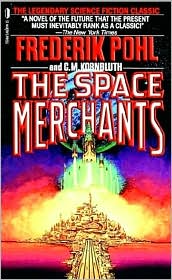The Space Merchants is a short sharp book the way they used to make them. It’s a future that extrapolates the advertising techniques of the early fifties and makes a nightmare future out of them. It’s pointed and satirical, but it’s kind of a one note joke—extending how advertising is manipulative, and making the quasi-religious attitude some companies have towards sales principles an actual religion. (I remember bits of it coming back to me very uncomfortably when I had a job in a company like that.) It’s a long time since I last read it, and I remembered all the atmosphere, some of the jokes, and none of the plot. (The plot’s pretty silly, and just what you’d expect from two hyper Futurians swapping the typewriter. No wonder I forgot it.)
The Space Merchants was first serialised in 1952 and published in book form in 1953. It’s typical of SF of the period in some ways—it mostly has horrible gender politics, there are nods towards characterisation, and it tries hard to stay close to the point of view of Mitchell Courtnay, its first person protagonist, but the important thing is the ideas. What was unusual about it and surprised people when it was new was taking an entirely sociological central idea rather than starting from the engineering. There are rockets in The Space Merchants, but it’s really about the copywriters, and it wasn’t made up from whole cloth, but written from a deep knowledge of how advertising worked at the time. (Pohl worked for a time in an advertising agency.)
Unfortunately, this central idea that seemed so cool then hasn’t aged all that well. The manipulations of the ad men look laughably simple, compared to the complexities of advertising now, because people have become less easy marks. We might have a consumer class, but we don’t have an advertising agency elite. Anyway, it’s not supposed to be prediction, it’s meant as satire. Unlike a lot of SF written at the time, it doesn’t have a continuing Cold War. The hunt for secret undercover “consies” (conservationists) clearly owes a lot to McCarthyism, but this is a future where capitalism didn’t just win but went rampantly rogue, where all the world is the worst bits of America.
Much more interesting as futurology are the incidentals of the background. This is a ridiculously over-populated Earth, only in Antarctica and around the blast-off range of Venus rockets is there any empty space at all. Rich people live alone in two rooms, with fold-out beds and tables. Privacy doesn’t exist. The entire planet is at worse than the density point of modern Tokyo. Well, there’s a future that didn’t happen, but you can see how in 1952 in the middle of the Baby Boom it looked as if it might. There are golf clubs on high floors of corporate sky scrapers.
It’s interesting to see conservationists so demonized, yet the forms of pollution and consumption everyone else is embracing so enthusiastically aren’t the ones that we see as the problems. They’re wearing “soot filters.” That kind of pollution turned out to be a fixable problem and is pretty much gone in first world countries. They’ve run out of oil and are pedaling their cars and using rockets for long distance travel, but there doesn’t seem to be any shortage of plastics. They don’t have any climate change problem, and they’re all eating hydroponic food and syntho-protein (with yummy addictive additives) because there’s literally no room for farms. They’ve paved the planet without having problems without the “lungs” of the rainforests. They’re also eating protein from Chicken Little, a giant chicken heart that keeps on growing and they keep on slicing—the image of that had stuck with me, especially the consie cell having a secret meeting in a chamber surrounded by it. And it’s weird to see the conservationists essentially giving up on Earth in favour of Venus. I’d forgotten that. This is a much nicer Venus than later probes have reported, it’s still pretty unpleasant but it’s comparatively easily terraformable. But even so!
I’m sure the idea of having short term marriage contracts seemed wonderfully innovative, and the idea of having our hero in love with a wife, Kathy, who won’t renew because of his attitudes (and secretly is a high-up consie) but that all reads very oddly now, in the same way romantic comedies are sometimes only a hairsbreadth from being stalker movies. I’m not judging 1952 by the standards of today, and they get a point for making Kathy a top heart surgeon, and a competent revolutionary. It still feels off. Kathy won’t renew, because she loves him but hates advertising. He also has a devoted secretary, Hester, who literally gives up everything for him and even kills herself for him. The fact that he’s a total jerk hasn’t apparently dawned on either of them.
Courtney being a jerk is what makes him real. He genuinely loves advertising, and sales, and it takes a lot to make him even think about reconsidering his attitudes. It’s chilling. This genuine love is what makes the future convincingly dystopic—imagine an ad for a boot flashing on a human retina forever. Even when he’s been shanghaied to a work camp where he’s getting deeper in dept every day and has to pretend to become a consie to get out, his actual faith in advertising is unwavering. He does eventually reconsider, and gets the girl and the trip to Venus. Abandoning Earth is the happy ending. I wonder if that seemed as odd in 1952 as it does now?
(By the way, Fred Pohl has a very interesting blog, which I commend to your attention.)










